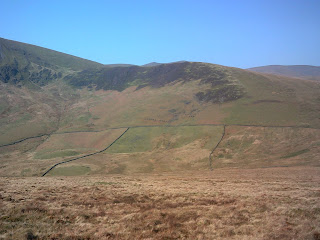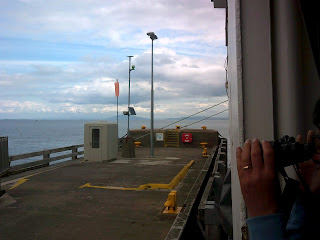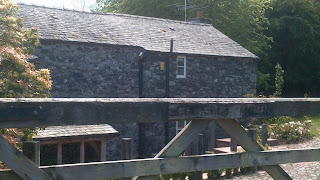Saturday, 29 June 2019
Inclined plane on Mungrisdale Common
I was impressed by this area of grassland on Mungrisdale Common. It is essentially what we call in Physics an inclined plane. On the 1:25000 Ordnance Survey map it goes up 50 metres of contours in 14mm. On this scale, 40mm = 1km. Now the catch is that the map gives the horizontal distance, the distance that would be some way underground from where I took my pictures. So you get a right angled triangle with a base that is 14/40 of 1km = 350m. The height is 50m. The angle above vertical is arctan(50/350) = 8 degrees. The component of acceleration due to gravity down the slope is thus 9.81*sin(8) = 1.4m/s/s. I've heard that described as "dilute gravity"!
Friday, 28 June 2019
Raised beaches on Jura
The raised beaches on Jura and Islay were particularly impressive, Through binoculars, I could see huge pebble beaches further up the coast of Jura which are now on the top of a small cliff. I have been struggling to work out how you end up with two beaches. My issue has been - wouldn't the first beach be worn down. I suppose I'd be expecting a lower beach and the upper level would be what used to be behind the beach. I know that there is isostatic rebound going on. I found one site that put a figure to it: 10cm over the next 100 years. That's 1mm a year. https://www.telegraph.co.uk/news/earth/earthnews/6226537/England-is-sinking-while-Scotland-rises-above-sea-levels-according-to-new-study.html It may not always have been fixed at that level. I wonder what the rate of erosion is of waves cutting into the beach. It is probably the same. Maybe the pebbles on the raised beach represent storm beach conditions so the regular erosion didn't reach it.
Thursday, 27 June 2019
Lazy-jack at Bunnahabhain
Pete emailed me to explain the previous conundrum about the ropes round the boom that don't raise the sail. Apparently they are called "lazy-jacks" and mean that if one person has to lower the sail in a hurry, it falls down a channel and not all over the deck. He writes: "These rope don't, indeed shouldn't, be taking any pressure when the boat is sailing. It would spoil the wing-shape of the sails and affect their performance and the rope breaking strain is usually too low for heavy work. Usually, the lazy-jacks will be loosened after hoisting the sail to ensure they don't interfere with the sail. Indeed, on some boats I've crewed on that have them, they are carried forward and lashed to the mast to ensure they have no affect on surface airflow (they have enough drag effect to affect performance of racing boats). When the sail is to be dropped, the lazy-jacks will be tightened up again before loosing the halliard holding the sail up." This made me realise that there is a lot about sailing that I don't understand. I occurred to me to ask why a sail needs to billow outwards and why it can't just be a solid board. One answer to that question can be found on http://physicsbuzz.physicscentral.com/2015/05/the-physics-of-sailing-how-does.html where the sail shape is deflecting the wind and using the reaction force to push the boat forwards. I'm definitely going to use this idea with my classes.
Wednesday, 26 June 2019
Stupidly steep on Graystones
The path up the side of Graystones from the Whinlatter road is ridiculously steep. I have long held a theory that stupidly steep walkers paths are always 45 degrees. No way to measure it on the hill so I worked out that with two equal length walking poles, I could tell if it was 45 degrees. The poles would make a right angle with their tops touching. I tried to use the straps as plumb lines to get as perpendicular as possible. Even on the mountain, it was clear that the angle would come out close to 30 degrees. I have taken a protractor to the background in the top photograph to confirm that. The trigonometry works out as arctan(7/13) = 28 degrees for the poles, based on measurements from an enlarged photograph where each pole as 13cm long.
Tuesday, 25 June 2019
Lens experiment
We used an illuminated triangle on a ray box to produce an object for a lens. The lens produced an image which we projected onto paper (above)
The height of the object was always 32mm but the height of the image depends on how close the triangle is to the lens. The closer the object is to the lens, the further the image is from the lens and the bigger the image is. We could tell when the image was properly focused by the cross-hair. The image was always inverted. We calculated the magnification by doing height of image/height of object.
The height of the object was always 32mm but the height of the image depends on how close the triangle is to the lens. The closer the object is to the lens, the further the image is from the lens and the bigger the image is. We could tell when the image was properly focused by the cross-hair. The image was always inverted. We calculated the magnification by doing height of image/height of object.
Sunday, 23 June 2019
Cirrus clouds over Wrynose Bottom: learning a new word
Cirrus clouds are well known for warning of approaching bad weather because they form ahead of a front. These clouds yesterday may be the herald of the thunder storms expected today, but there does seem to have been a much longer time delay than I understood to be the case. They form ahead of a warm front when hot and cold air meet. Well, they certainly heralded the arrival of very warm air though not rain today. Cirrus clouds are at least 6km up in the atmosphere, so probably even higher than Everest. Looking them up again, I learned a new word - deposition https://www.metoffice.gov.uk/weather/learn-about/weather/types-of-weather/clouds/high-clouds/cirrus I know that sublimation means going directly from solid to gas but deposition is apparently the word for the direct transition from gas to solid.
Sunday, 16 June 2019
Trying to understand the geology of Lagavulin Bay
After a week of looking out at the view of Lagavulin Bay, it dawned on me that the sea must have worn through a ridge of hard rocks and then opened out a bay into softer rocks behind. The line of the harder rocks can be seen across the bay from Dunyvaig Castle. The south end of Islay has a succession of ridges parallel to the sea. The bank by the cycle track below is made of schist and runs down to the side of the bay.
Behind the pods across the back of the bay exposes a much harder rock. It looks a bit like the hornfels we find in the Lakes.
So I was putting together a hypothesis in my head that there had been igneous intrusions that made harder layers but that the schist was in between and wore away. I don't think that can be true because the schist makes up one of the ridges. I'd hoped to find the answer on the Internet but there is little about this end of Islay on a cursory inspection. There is a geological map here https://www.islayinfo.com/islay-geology.html that puts these rocks into the Argyll group https://en.wikipedia.org/wiki/Argyll_Group
Saturday, 15 June 2019
Pulling up the sail at Bunnahabhain
I've never been so close to a sailing ship as with the Flying Dutchman at Bunnahabhain. I was interested in the triangular ropes either side of the sail. I wondered if it was a mechanism for reducing the force needed to raise the sail by using multiple ropes but inspection of the photographs shows that the ropes are probably there to keep the sail in a channel. There only seems to be one rope next to the mast that actually raises the sail. That appears to be a double rope around the pulley which means that the pulling force on the rope would only be half the weight of the sail.
Friday, 14 June 2019
We only do positive?
Keswick AFC have a fantastic banner which reads "We only do positive". I think that's a great way to love but I was wondering where that leaves Physics. We have positive and negative charges. Positive and negative have meaning in vector fields. All gravitational potentials are negative. Maybe I should concentrate on scalar quantities like kinetic energy. The velocity, which as a vector can be positive or negative, is squared to make all values positive. Kinetic energy: we only do positive.
Thursday, 13 June 2019
Colonsay electric car charger: don't stand so close to me
This is the electric car charging point at the ferry terminal on Colonsay. I was alarmed to read the notice below:
I have been trying to find out how much current it draws. It's hard to get a definite answer. It could be 32 Amps. It could be 16 Amps. Let's take the higher figure. Magnetic field strength around a cable =mu0*current/2pi*radial distance. Permeability of free space mu0 is 4pi x 10^-7 Tm/A. So at a radial distance from the cable, magnetic field strength = 32 micro Teslas. Field strength for the Earth's field is about 30 microTeslas. My calculation suggests that less than a millimetre from the cable, the field would be as strong as the Earth. Maybe it is the alternating field that causes the problem, not the overall strength.
I have been trying to find out how much current it draws. It's hard to get a definite answer. It could be 32 Amps. It could be 16 Amps. Let's take the higher figure. Magnetic field strength around a cable =mu0*current/2pi*radial distance. Permeability of free space mu0 is 4pi x 10^-7 Tm/A. So at a radial distance from the cable, magnetic field strength = 32 micro Teslas. Field strength for the Earth's field is about 30 microTeslas. My calculation suggests that less than a millimetre from the cable, the field would be as strong as the Earth. Maybe it is the alternating field that causes the problem, not the overall strength.
Wednesday, 12 June 2019
Brian Cox does The Planets
I've finally had time to catch up with the new Brian Cox series https://www.bbc.co.uk/programmes/p07922lr Website implies that these programmes will be up for a while. I was always so impressed by the photograph that was taken on the surface of Venus and that features. It also brought me up to date with the latest theories about Mercury.
Sunday, 9 June 2019
Sgriob na Cailliche lateral moraine
We had seen on the map of Jura that there is an impressive glacial feature on the west side of the Paps, the inaccessible side. So I was really pleased that the feature was really obvious from the ferry to Colonsay. It is a long straight line of rocks over 2 mile long making its way down the hillside. It runs diagonally down the middle of this picture.
In the picture below it is clear that it is more than one line.https://www.geograph.org.uk/photo/4983084 has a picture taken looking down the line of the rocks from the hillside above and explains the legend. My Gaelic dictionary gives one translation of sgriob as "furrow". The double line looks a bit like that. http://jncc.defra.gov.uk/pdf/gcrdb/GCRsiteaccount979.pdf has the full explanation. It is thought that the peaks of the Paps poked out above the ice forming nunatak peaks. The glacier split to go round them and where the glacier recombined, rocks were dropped in a long line. It is remarkable that over 10000 years later it remains uncovered by vegetation.
Saturday, 8 June 2019
Measuring temperature at Kilchoman
I was interested that the Kilchoman distillery was using analogue thermometers. The resolution is +- 2 degrees Celsius. Also note that they are cross-wired: the upper thermometer is connected to a sensor lower in the tank so the temperature does get lower as you go up the tank. I wonder if the use of analogue is because they have a more averaging effect on the reading. In the era of high resolution digital instruments, the reading can seem to go up and down rapidly. But how relevant would that be in a large tank where local fluctuations wouldn't give an overall picture? I did see an examination answer recently that suggested that an analogue scale was better for monitoring a reading that needed to be kept roughly constant because you can draw on a line to show the necessary reading and that it easier to understand.
Friday, 7 June 2019
Is this a benchmark on St Raven's Edge?
I found this on the way up Caudale Moor from Kirkstone. It definitely looks like a survey benchmark with a small dint above the point of the arrow for an instrument. I can find no mention of it anywhere, though. The grid reference is approximately NY 419 088.
Wednesday, 5 June 2019
Stopping the ferry on Colonsay
When the ferry docked at Colonsay, you could see the two hawsers in the top photograph pulling tight to stop the ship. I looked over the side and timed 60 seconds, trying to work out how far the ferry moved in that time. I'd estimate 4 metres in 60 seconds before the ropes began to tense. That's 0.07 metres per second. The mass of the ship is about 3,000,000 kg so the momentum is about 200,000 Ns. If it then takes the hawsers 60 seconds to bring the ship to a standstill then the average rate of change of momentum is of the order of 3000N so 1500N on each hawser. If the ship is moving very slowly and the time to stop if long then the forces needn't be huge. Next time I go I need to get a more accurate time to stop after the hawsers become tense and I need to find out about the hawsers to calculate their properties.
Monday, 3 June 2019
Fred Hoyle's house
Clive Hutchby's excellent revision of Wainwright's Eastern Fells points out in the chapter on Great Dodd that this house above Dockray was the home of Fred Hoyle between 1965 and 1975. Fred Hoyle did some brilliant work on fusion in stars and how heavier elements were formed. It is called stellar nucleosynthesis. He comes up in class when I teach the development of the Big Bang theory. He had a rival theory called the Steady State which suggested that the Universe was expanding because new material was being created everywhere all the time rather than at one time in the past. I've always thought it was a logical idea based on what was known at the time but of course it couldn't survive the discovery of the Microwave Background Radiation. The dates in the Wainwright don't fully tie in with Wikipedia but make your own mind up! https://en.wikipedia.org/wiki/Fred_Hoyle
Sunday, 2 June 2019
Microgabbro on Carrock Fell
We also found microgabbro on Round Knott just before we reached the summit of Carrock Fell. According to the book "Exploring Lakeland Rocks and Landscapes" published by The Cumberland Geological Society, the darker layers are augite and the paler layers are plagioclase. Gabbro is a plutonic rock that cools a long way underground so grows large crystals. The idea is that the augite crystallised first and sank to the bottom, depleting the magma of iron and magnesium. That made the liquid over-rich in aluminium and calcium so plagioclase crystallised out. This restored the original chemical balance and the cycle repeated, hence the layers. A further note to my wondering about granophyre or microganite for the summit: it is called granophyre in the book The English Lake District by Pearsall and Pennington.
Subscribe to:
Posts (Atom)


































